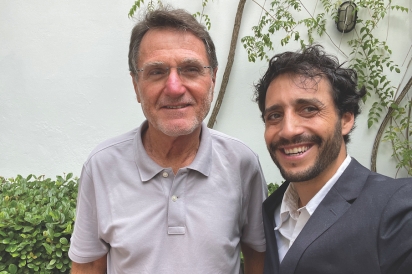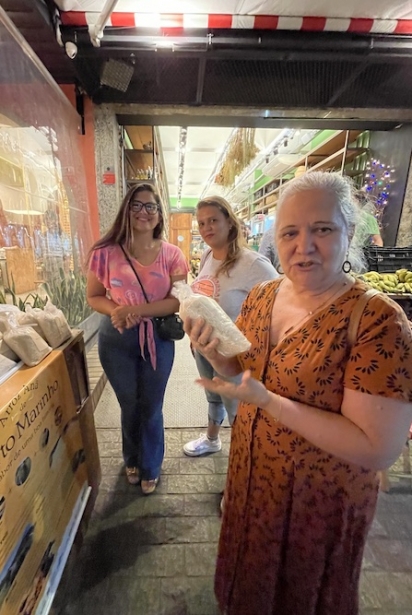Behind Brazil’s Contrasts, a Food Policy Pioneer
It was an unassuming venue for one of the most delicious meals I’d ever had: row upon row of long communal tables, walls bare of any decor, and no-nonsense, hairnet-clad workers serving the food school-cafeteria style. But the 60-cent meal—balanced and curated by nutritionists—that I enjoyed at Brazil’s largest “people’s restaurant,” in the city of Belo Horizonte, was one of many examples of the contrasts I experienced in Brazil, while on the Eisenhower Agricultural Fellowship last December.
When people think of Brazil, images of Carnaval and its colorful costumes or exotic beauties on white-sand beaches might spring to mind. For others, crime, civil unrest, deforestation, and the antics of ex-president Jair Bolsonaro might dominate the conversation. But there’s a lot more going on between these contrasts in South America’s largest country. Brazil is the third-largest agricultural-producing country in the world, and its pioneering policies around agricultural support for small-scale producers, hunger relief, indigenous land practices, and reforestation are what we should be talking about—and models we could all learn from.
‘The people’s restaurants’
For me, going to Brazil was truly full circle. When I was studying sustainable food systems in university nearly two decades ago, a documentary featuring Belo Horizonte and its pioneering approach to farmer support and hunger relief through the people’s restaurants (restaurantes populares in Portuguese) inspired me to put together a free farm-to-table meal for the community back home in Aspen. That successful event grew into an initiative, which set the foundation for what is today the Farm Collaborative (the nonprofit that publishes this magazine). And now, thanks in part to my role as executive director of that organization, I was able to travel to Brazil to meet with and learn from policymakers, farmers, restaurateurs, activists, and community leaders, as part of the Eisenhower Fellowships’ mission to build bridges of understanding across cultures and work together to better our world.
The people’s restaurants are government-run public cafeterias with a broad humanitarian purpose. Menus, coordinated by nutritionists, are culturally specific to each region. Meals cost three Brazilian reals (about 60 cents in December 2022) for the general public, half of that for people living in poverty, and free for those experiencing homelessness. The true cost of the meal, closer to 10 reals, is subsidized by the government. At least 15 percent of ingredients must come from local sources, and the government is required to purchase organic when local organic options are available. Whole grains are used whenever possible, processed foods are prohibited, and frozen ingredients are almost never used.
“One of the most beautiful things about the [people’s restaurants] is that it is not unusual to get a homeless person sitting next to a doctor, both just being human,” says Wellemy Silva, director of Belo Horizonte’s restaurantes populares. “In a country where over one-third of all citizens live on minimum wage or less, wealth disparity is a big deal. There is little chance for upward mobility, and even fewer chances for people of different classes to rub elbows, much less eat a meal together.”
In this simple way of bringing people together around a meal, people’s restaurants not only provide significant hunger relief but also break down socioeconomic barriers and the stigma of relying on government aid to eat. And they do all of this while supporting regional farmers.
“When people eat well, they make better choices,” says Walter Belik, an economics professor who wrote Brazil’s zero-hunger policy for President Luiz Inácio Lula da Silva during his first administration. Belik, who in his “retirement” facilitates a food bank that supplements food for 30,000 people per week, may be the strongest hunger relief advocate I have ever met. Over coffee in his home office in São Paulo, he tells me about another pioneering Brazilian program addressing food system resilience and equity.
Better food for kids
“Our school meal program is the main vehicle for hunger relief,” says Belik, who helped create the federal program.
The Programa Nacional de Alimentação Escolar (PNAE) allocates money from the federal government to city halls throughout the country “to make sure our children are eating well and healthy,” Belik tells me.
The program also sets goals for eliminating food waste, and it requires that 30 percent of the food served in schools come from local family farmers, according to Lia Palm, agricultural and food security coordinator for the City of São Paulo. “We have a further goal of having 100 percent of the food served in our schools to be organic by 2026,” she tells me. Palm is also working on a whole suite of other local farm support programs for the region to increase the amount of local food the community consumes while increasing revenue and resources for the farmers.
To help meet the goal of 30 percent locally sourced school food, the Brazilian government contracts with public extension services in each state called EMATERs (which translates to Enterprise for Technical Assistance and Rural Extension) to build links with local farmers.
This collaborative effort recently helped boost the amount of local food in schools in the state of Minas Gerais from just over 20 percent to upwards of 40 percent in some places, according to Otavio Maia, president of EMATER–Minas Gerais. “We provided technical assistance to 15,000 producers in 100 municipalities in the state to help them get necessary certifications and organization to get their food to our 3,500 regional schools. As a result, we are on track to get each and every one of these schools and the two million students there to have at least 30 percent of their food coming from local farms this year.”
EMATER also helps farmers secure certifications. Farms certified as organic see a nearly 30 percent increase in their revenues, and regional governments must prioritize purchase from them when available.
Some of the local food going to schools is grown on abandoned urban plots of land run by farmers living in poverty. I visited a few of these farms in São Paulo and in Belo Horizonte—one under a power line where buildings could not be constructed, another under a freeway bridge—and met primarily older farmers, growing on what looked like large-scale community garden plots with several other families.
“While some people are just growing food for their own sustenance, the majority of these farmers grow food as their primary livelihood,” says Regiane Nigro of Kairos Institute, who is on a contract with the municipality of São Paulo, through Lia Palm, to support and network with urban farmers and generate recognition and land security for the plots they tend.
Palm and her team are working on a whole suite of local farm support programs for the region to increase the amount of local food the community consumes while increasing revenue and resources for the farmers.
Another of these programs, Nigro tells me, contracts unemployed people living in poverty to work and learn on regional farms, like a paid internship. The monthly salary, 1,400 reals or around $270, is above Brazil’s minimum wage. “One of the benefits of the program is that aspiring farmers of all ages are being introduced to farming, and get paid to do so,” says Nigro. This program holds promise to not just create pathways for employment for individuals, but to grow new farmers for the country.
Indigenous techniques for the future
In the state of Rio de Janeiro, I met with grassroots leaders working to elevate the integrated land stewardship techniques of Brazil’s original farmers: indigenous natives.
One particular family farm (fazenda in Portuguese), in the municipality of Silva Jardim, was a model of ecologically beneficial agriculture, with an eco-tourism component designed to educate guests on the benefits of these techniques.
According to Ayrton Violento, director of tourism for Fazenda dos Cordeiros, 93 percent of the Atlantic rainforest (which extends along most of its Atlantic coast and inland as far as Paraguay) is deforested. But, he tells me that he and his family, along with some nearby farmers, “are working on modeling indigenous techniques of agroforestry to create a profitable demonstration of how agriculture can support us and the environment.”
One of the main tree crops being tested is the native juçara tree. A palm known as the “mother of the Atlantic forest” because it provides food to so many species of birds and mammals, it was cut almost to extinction to extract hearts of palm. Now being grown as a canopy tree—protecting plants below it and encouraging crop growth, among other important roles it plays in the forest ecosystem—it also produces a tasty fruit similar to an acai berry. The juçara berry can be harvested for sale and it also feeds the golden lion tamarin, an endangered endemic species of monkey that drives much tourism to the region.
Lucas Xumu, a leader of the Guarani people in Aldeia Sapucaia, a tribal village in the state of Rio de Janeiro, shows me how the tribe’s agricultural practices reforest the region while feeding its people. I walk through a beautiful forest canopy that feels wild and natural, like I imagine the Amazon to look like, with interspersed recognizable food and fruit crops as part of the forest ecosystem.
“Many indigenous communities live as close as 20 kilometers from our city centers, and have a completely integrated and isolated food system,” says Teresa Corção, one of the most inspiring and humble community leaders I met in Brazil. A former renowned chef who presents internationally, Corção founded Maniva Institute, an organization that links chefs with indigenous farmers to use cuisine to elevate agricultural value of integrated land practices.
Corção brings me to a rice presentation, in which indigenous women farmers present heritage rice they’ve cultivated that is for the first time ever available to people outside of their community. (It’s delicious!)
“We had to take our time to do this right,” she tells me. “The community wanted to generate livelihood from their agriculture that has always been just for sustenance, but wanted to do so in a way that preserves the integrity of their growing practices and keeps their community values intact. So we have spent several years getting this to market so as to make sure we do it with integrity.”
Brazil is such an anomaly to me. The same country where historic government corruption has led to illegal deforestation, loss of indigenous land, and significant margins for the biggest producers also has some of the most meaningful policies to support smaller farmers growing in unison with nature. The same country that still struggles with crime, poverty, and workers’ rights has the right to food and hunger relief embedded in its national constitution. If we take the time to look beyond the headlines and stereotypes, and study the positive sides of Brazil’s contrasts, there is so
much we can learn from this unique country. ❧









